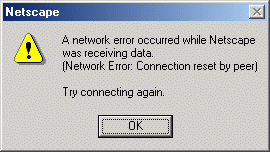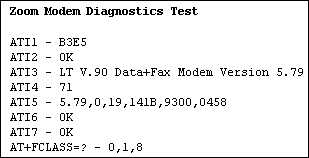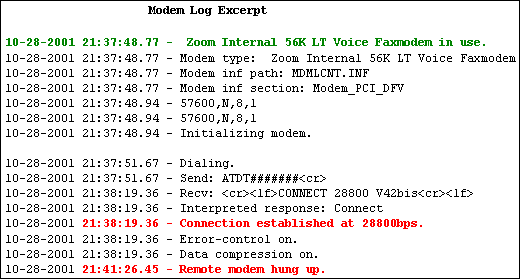|
I am sure you have all heard repeatedly, as I have, how user
friendly today's computers are. The TV Shopping Channels probably
pitch this more than anyone else. They tell you that if you ever
do have a problem, Tech Support is always just a free phone call
away and so there is absolutely no reason not to buy that new
computer. I thought about this first time computer buyer, the
“computer novice” or “newbie,” when I ran
into this problem.
It was a day in late October of last year. My one GHz computer
purchased in the Spring had been humming along great for months.
I was consistently connecting via my Zoom Internal 56K LT Voice
Faxmodem at 49333 bps (bits per second). Then suddenly and without
warning I could not connect above 28800 bps. The modem was also
doing a double handshake in its effort to negotiate a connection.
I was hearing the modem tones followed by a static sound, followed
again by modem tones, before the verifying password dialog box
came up. The connection established was always at only 28800
bps. What had happened?
 Connecting
at only 28.8K was bad enough but I soon discovered the worse
part. The connection would randomly dropout anywhere from three
to 40 minutes into a session and usually within ten minutes.
This made it impossible to download in one session any relatively
large file (like the electronic version of the Space Coast PC
Journal) or the 20 plus e-mails I get each day. Connecting
at only 28.8K was bad enough but I soon discovered the worse
part. The connection would randomly dropout anywhere from three
to 40 minutes into a session and usually within ten minutes.
This made it impossible to download in one session any relatively
large file (like the electronic version of the Space Coast PC
Journal) or the 20 plus e-mails I get each day.
I now had a “modem mystery” on my hands. What had
happened? Did my 56K modem suddenly become a 28.8K modem? Had
the house wiring connecting my phone line to the modem deteriorated
to the point of causing a modem connection problem? Had the phone
company line to my house deteriorated? I began the search for
an answer that would take over a month to solve. Now, I do not
consider myself a computer expert, but I do have a bit of knowledge
based on some years of experience living through Windows 95,
98, and currently ME (Millennium Edition). But just think of
that computer novice with this problem on his hands.
My first thought was that my Internet Service Provider (ISP)
K2services.com had changed something, as earlier that very evening
I could not connect to them at all. A call to K2 verified that
they had changed a router (a device for switching connections
to configure the best and most efficient route between any two
host computers) but as far as they knew that had not caused any
problems. No one else was reporting connection problems. A check
with several friends on K2 did indeed confirm that I seemed to
be the only one with a connection problem.
Unlike most computer users I am fortunate enough to have two
computers: my new one GHz ABS Computer Technologies computer
and my old 233 MHz Gateway. The 233 MHz computer has two modems
installed in it: a 56K Ambient Technologies Win type (controllerless)
modem which I added and also the original 33.6K US Robotics hardware
type (controller on board) modem. Yes, you can have two modems
installed on a computer and by changing the selection in “Dial-Up
Networking” decide which one to connect with. A Win type
modem uses your computer's processor for control through software.
Thus, it is robbing your computer of part of its processing power
while in use. With today's high speed computers this is no longer
much of a factor. Therefore, Win type modems now come with most
new computers, a key reason being they are cheap ($20-$30) and
thus keep the overall system price down. A hardware type modem
is much more expensive ($70 to over $100) because the modem is
controlled by hardware actually on the modem card.
Since the modem on my new computer would not connect above
28.8K and kept dropping the connection I decided to see what
the two modems in my old computer would do. Sure enough the 56K
Ambient Technologies modem connected flawlessly at 49333 bps
to K2services.com. Likewise the 33.6K US Robotics modem connected
flawlessly at 31200 bps. There was no dropped connection with
either. This again seemed to confirm that my Internet Service
Provider was not the source of the problem. But I still had this
“modem mystery” on my hands. At least it was reassuring
to know that I could continue to perform my SCPCUG Web Master
duties and connect to the Internet whenever necessary with no
problems by using my old computer.
Where to go from here? I had already run the Windows Modem
Diagnostics test (find it in Modem Properties) which indicated
the modem was responding properly to commands. Perhaps the wire from the telephone wall jack to the modem was bad? Maybe
the modem surge protector? To make this long story shorter suffice
to say, I played around changing all of the wires, eliminating
the modem surge protector, disconnecting all the phones in the
house, and even running a direct line from the phone company
interface junction box on the wall outside the house to the modem.
I then tried various modem initiation strings trying to force
a 56K connection and even a 33.6K connection. Nothing helped
to solve the problem.
wire from the telephone wall jack to the modem was bad? Maybe
the modem surge protector? To make this long story shorter suffice
to say, I played around changing all of the wires, eliminating
the modem surge protector, disconnecting all the phones in the
house, and even running a direct line from the phone company
interface junction box on the wall outside the house to the modem.
I then tried various modem initiation strings trying to force
a 56K connection and even a 33.6K connection. Nothing helped
to solve the problem.
And then a glimmer of hope! I picked up the phone to make
a call and heard faint voices on the line. Could it be I had
a noisy line? Although I did not remember hearing this before,
maybe I just never listened carefully enough. I called the phone
company. They did a line check and fixed something as I no longer
heard the voices but they said there still appeared to be some
noise on the line and would send a man out. The next day the
phone company man came out and checked the phone line to the
house interface box. He said the line was marginal and switched
me to a more quiet line. Hopes of that solving the problem soon
faded when I fired up the one GHz computer only to get the same
28.8K modem connection that was soon dropped. The mystery continued.
When the connection was dropped I would get dialog boxes saying
things like “A network error occurred: unable to connect
to server [TCP Error: No route to host]. The server may be down
or unreachable.” or “A network error occurred while
Netscape was receiving data [Network Error: Connection reset
by peer].” Looking at the modem log indicated that the “remote
modem hung up.” This appeared to show that my ISP was dropping
the connection.

But why? Was my modem connection speed slowly dropping to
the point where the connection could no longer be maintained?
I decided to conduct a test by connecting and then downloading
a large file (the sample Space Coast PC Journal on the SCPCUG
web site). I could then continuously watch the download speed
in the download dialog box to hopefully the point of disconnection.
That worked great! It showed my download speed remained relatively
constant. More importantly what it showed was that my modem suddenly
quit talking. In the middle of the download the modem icon lights
went black and after approximately 30 seconds the connection
was dropped. So what was actually happening was the remote modem
(K2services.com) was sensing that my modem quit talking and after
a given period of time with no communication hung up.
I was just about to conclude that there was something wrong
with the Zoom modem in my new computer and ship it off to ABS
Computer Technologies for a replacement when I decided to try
one more test. I found the phone number for another ISP and had
my modem dial it. I connected at 49333 bps and then, since I
had no password for authorized access, was dropped. How do I
know I actually connected? Again, by the modem log. It shows
you what the modem did during it's last use. In my case it proved
a very important point. The modem apparently worked fine with
another ISP but not my ISP. What now? It looked like my modem,
for whatever reason, was now incompatible with my ISP. How do
I solve this problem? A favorite solution of computer experts
when nothing seems to fix a problem is to say “update the
drivers.” Maybe that was one avenue I should have pursued
earlier but hindsight is always 20/20.
Since the modem in my new computer was made by Zoom I visited
the Zoom web site (http://www.zoom.com)
in hopes of finding information about my problem. There was a
lot of information available but nothing that appeared to be
my problem. I tried looking for new drivers but could not find
my model number in the list. I did find that the “LT”
in the modem name “Zoom Internal 56K LT Voice Faxmodem”
meant it uses a Lucent Technology chipset.
I decided to call Tech Support at ABS Computer Technologies.
This was my first call for help to Tech Support on my one GHz
computer and I was pleasantly surprised when a person actually
answered the phone after only a few minutes on hold. No long
on-hold times! I told him my problem and that I was looking for
new drivers for my Zoom modem. He told me how to download the
modem drivers directly from the ABS web site. You have to type
in the part number in a search form to get the download page.
I downloaded the drivers and thought I was finally on the way
to solving my modem problem until I discovered in the Readme.txt
file that the drivers were for version 5.75. That was older than
the version 5.79 drivers I already had installed on my computer.
Interestingly, the “readme” file showed a different
Zoom modem model number, 2925L, than the 1120L model I had. I
went back to Zoom's site and looked up the 2925L model number.
That model was indicated with a driver for a Microsoft BackOffice
Small Business Server. It had a hyperlink for use with Win 95/98/NT
(without MS BackOffice Small Business Server). I clicked on the
link and up comes a page listing my model 1120L. Talk about confusing!
Well the roller coaster ride was not over yet. It turned out
the driver Zoom had listed was also ver 5.75.
So here I was dead in the water again. Guess I could not fault
ABS Computer Technologies for having an old driver as Zoom is
their supplier and they can only make available whatever Zoom
makes available.
I had already tried several modem help links listed under
Hardware Information on our SCPCUG Hardware Links page
(http://www.scpcug.com/hardlink.html)
and found no help for my problem. And so it was by a stroke of
luck I found an old sheet of paper that SCPCUG member Dick
Melloh had given me over a year ago with some web site links
for troubleshooting connections and modems. (I of course had
dutifully filed it away for future use should a problem arise
and then forgotten about it.) I tried Modemsite.com: 56k Modem
Drivers, Information and Troubleshooting at http://808hi.com/56k/index.asp
and hit the jackpot. Here was a wealth of information. This site
had everything I had been looking for: Modem Troubleshooting,
Modem drivers, How to update Drivers, AT commands, Handshake
sounds, etc.
This site was a real education! I discovered that the ver
5.79 drivers already installed on my computer were actually installed
as part of the Windows ME installation. They do not appear to
be available as a separate release. It was not recommended that
I go back to ver 5.75 as there are now two types of drivers:
WDM (Windows Driver Model) compliant (.sys) and the older .vxd
(Virtual Device Driver) type. Windows ME ships with both versions
but defaults to the WDM/.sys drivers. The ver 5.75 drivers were
only the old .vxd type. It is apparently tricky to switch back
to the older .vxd type from the new WDM/.sys type. Sure glad
I did not use the brute force approach (as I already had the
ver 5.75 drivers downloaded) and try that. I could have been
in a world of hurt.
I also found out that updating the drivers updates the firmware
within the modem. To my surprise there had been a number of upgrades:
5.87, 5.92, 5.97, and now 6.0. These are Lucent Technology “generic”
LT Win Modem Drivers. Reading through the readme files of these
upgrades showed that Lucent had been continually working on improving
modem capabilities and reliability. This included performance
improvements on phone lines with load coils, calling servers
on loaded loops, improved handshake/training for recovery error,
etc. It sure sounded like updating the drivers to ver 6.0 might
help my situation. Here Lucent has been working on improving
the modem chipset operation all along but Zoom had never bothered
to pick up on this and update the drivers on their web site.
So much for going to the modem manufacturer for the latest drivers.
I downloaded the generic ver 6.0 drivers, installed them,
and have not had a problem since! The generic ver 6.0 drivers
support all modems based on the “LT” chipsets and all
Windows operating systems (Win9x, ME, NT4, 2K and XP). Download
is available from Agere Systems at http://www.agere.com/modem/driver2.html.
Agere is the new name for the Lucent Modem Division.
My modem is now identified in Windows ME as a Lucent Win Modem
rather than a Zoom Internal 56K LT Voice Faxmodem. Don't know
how that plays with the warranty but hey, it now works! Before
this connection problem started, 90% of the time I would connect
at 49333 bps. Now I connect 90% of the time at 50333 bps and
10% at 49333 bps. Thus, my connection speed has also improved.
And so my modem mystery is over. It's hard to say who is at
fault. Certainly my ISP has a right to change and upgrade equipment.
Was it poor initial design of my modem or it's drivers that caused
this connection problem? Guess I'll never know for sure. I'm
just glad my modem is working properly again.
I now look back on this adventure as a real “learning
experience.” I have to wonder what would have happened if
this problem had occurred to someone new to computing. Without
another computer and modem to compare, that person would have
assumed the modem had gone bad. The computer maker's Tech Support
people might have agreed and replaced the modem only to have
the same thing happen all over again. Computers may be more friendly
than they were a few years ago but I still think they have a
way to go before I will feel “really” comfortable.
Finally, in fairness to Zoom, I must report that I went back
to their web site in mid February 2002 and found they had completely
revised its look. In updating their site they finally added the
ver 6.0 drivers under modem model 2925L. However, now they do
not even list my model 1120L.
Note: Web Master Wanderings articles
contain links to external web sites. Web addresses are constantly
changing. There is no guarantee that the information links provided
in this article will remain unbroken or up-to-date beyond the
date that this article is originally published. |